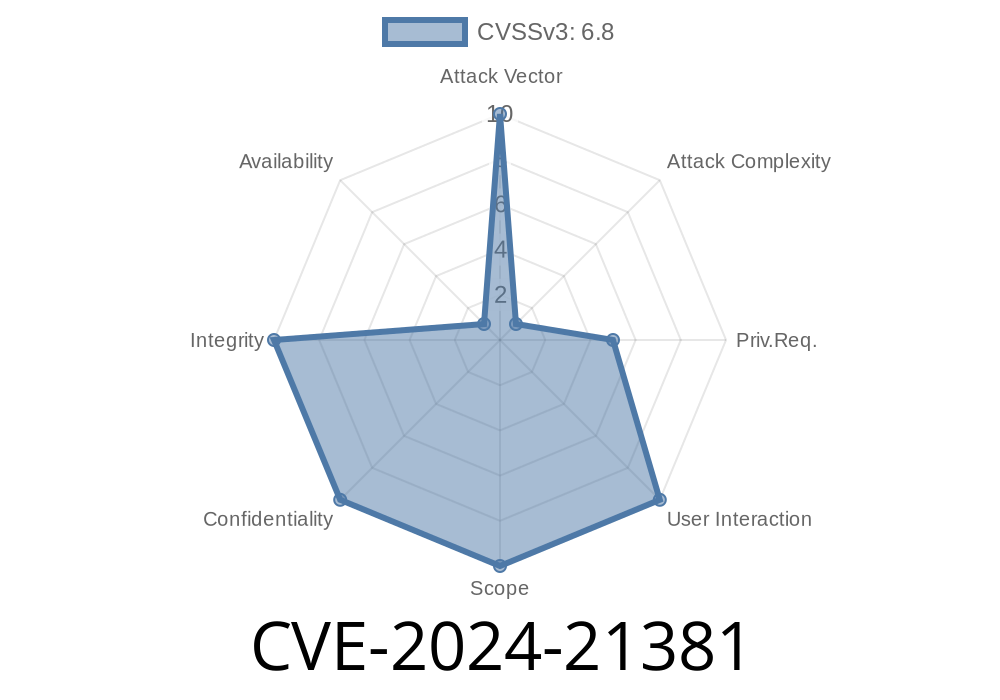In the world of cybersecurity, identifying and eliminating vulnerabilities is of utmost importance. Companies like Microsoft continually invest in securing their products, which is why it's crucial to stay updated on the latest vulnerabilities found and actively work toward mitigating them.
In this blog post, we will cover the recently discovered CVE-2024-21381, a spoofing vulnerability found in Microsoft Azure Active Directory B2C. We'll explain what this vulnerability entails, provide you with code snippets to better understand the issue, and discuss the potential impacts of exploiting it. Additionally, we will look into remediation steps to help you stay protected.
What is CVE-2024-21381?
CVE-2024-21381 is a security vulnerability found in Microsoft Azure Active Directory B2C, which falls under the category of spoofing. This vulnerability allows an attacker to spoof the system into thinking they are a legitimate user, potentially gaining unauthorized access and sensitive information. With the wide usage of Azure AD B2C, this vulnerability puts organizations at risk and emphasizes the need for immediate action.
Official references related to this vulnerability can be found here:
- NVD - CVE-2024-21381
- Microsoft Security Advisory
Details of the Exploit
In a typical attack scenario, an adversary may exploit the Azure AD B2C vulnerability by intercepting and manipulating authentication tokens, leading to unauthorized access. The root of this vulnerability lies in how the authentication mechanism works in Azure AD B2C.
Consider the following code snippet that demonstrates a simple authentication process
def authenticate_user(token):
user_profile = decode_token(token)
if verify_signature(user_profile):
return True
else:
return False
def decode_token(token):
# Decoding the token and returning user profile
pass
def verify_signature(user_profile):
# Verifying the digital signature in the user profile
pass
In this example, the authenticate_user() function decodes the token received from a user, verifies the digital signature, and determines whether the user is granted access. An attacker can take advantage of this process by intercepting the token, altering the user profile data, and then forging a valid signature.
When the manipulated token is used in the authentication process, Azure AD B2C may fail to recognize the forgery and grant the attacker unauthorized access.
If exploited, the CVE-2024-21381 vulnerability can lead to the following consequences
1. Unauthorized access to resources and sensitive information: An attacker with a spoofed identity can gain access to restricted areas, potentially resulting in data theft or unauthorized modifications.
2. Potential privilege escalation: The attacker may leverage the granted access to elevate their privileges, causing even more significant harm to the organization's systems.
3. Reputation damage: An exploited vulnerability may lead to a loss of trust from customers and partners, damaging the organization's reputation.
Mitigating the Vulnerability
Microsoft has provided patches to mitigate the CVE-2024-21381 vulnerability. Organizations using Azure AD B2C should initiate the following steps immediately:
1. Update the Azure Active Directory B2C service to the latest version. Microsoft has released patches addressing the vulnerability.
2. Implement additional security measures, such as multi-factor authentication (MFA), to add an extra layer of protection and reduce the risk of unauthorized access.
3. Review your system logs and monitor for any suspicious activity that might indicate unauthorized access or exploitation attempts.
Conclusion
The CVE-2024-21381 vulnerability is a serious concern for organizations using Microsoft Azure Active Directory B2C. Therefore, it is essential to take immediate action to mitigate the risks associated with this vulnerability. Stay informed of the latest security updates, implement robust security measures, and actively work toward protecting your organization's most valuable assets.
Timeline
Published on: 02/13/2024 18:15:56 UTC
Last modified on: 02/23/2024 16:11:13 UTC
